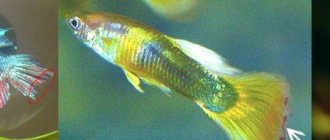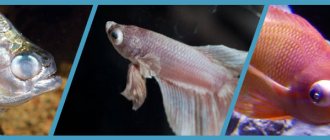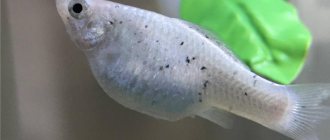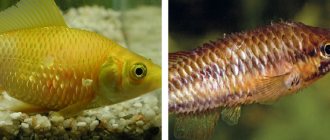Poor quality of aquarium water
This does not mean that the water is very dirty or. No, it can be relatively clean, but poisoned by toxic chemical compounds that are formed as a result of the life of fish.
Harmful chemicals
We are talking about nitrogen compounds, which include ammonia, ammonium, and other nitrates. These toxins will inevitably be present in the aquarium, since fish leave a lot of waste every day, which constantly decomposes.
Thus, the visual purity of water is often accompanied by the appearance of an unpleasant smell of rot, which indicates a high concentration of toxic nitrogen compounds.
This smell is especially noticeable if the aquarium is overcrowded and the biological water treatment system cannot cope with the processing of toxins.
This state of aquarium water occurs in the following cases:
- ecological balance has not yet been achieved in the new aquarium;
- beneficial bacteria that convert toxic nitrites into neutral nitrates are not yet working at full capacity;
- new fish have been added to the working balanced aquatic system;
- overcrowding of the aquarium;
- biofilter malfunction;
- improper maintenance and cleaning of the biofilter, resulting in the destruction of the colony of beneficial microorganisms.
Water parameters and adding fish to the aquarium
Poor quality of the aquatic environment is also a violation of the pH balance and a discrepancy between the water hardness and the usual conditions for the existence of aquarium pets.
There are often cases when a person brings a fish he has just bought from a pet store and immediately releases it from the bag into his aquarium, without thinking at all that the pet may experience a natural shock from the discrepancy in the parameters of the environment. And as a result, death within the next 24 hours.
Therefore, you need not only to know the exact conditions of keeping a particular species, but also to check with the seller about the water parameters in the pet store. And if necessary, organize a procedure for adapting the new fish.
Water temperature
The death of fish can also occur due to a decrease or increase in the temperature of the aquatic environment. The opinion that a deviation from a certain temperature regime by 2-3 degrees in one direction or another will not in any way affect the health of aquarium pets is deeply erroneous.
Dropsy
Dropsy is a very serious disease that occurs due to various reasons: bacterial infection (often the fish becomes infected with it when digging), improper feeding, increased ammonia levels, etc.
Dropsy can be identified by the presence of the following signs:
- bloated belly;
- the fish stopped eating;
- red spots appeared at the base of the fins;
- there are bruises on the body;
- rapid loss of body weight;
- swelling of the eyes.
As a rule, this disease leads to the death of betta fish. But there is a certain chance of saving sick individuals if treatment is started at an early stage. In addition to the use of certain drugs, a complete replacement of all decor and disinfection of the aquarium is necessary.
Aggression of tank neighbors
Even if a large fish is considered a herbivore, it can easily eat small animals that fit into its mouth. For many inhabitants of the home pond, the degree of aggression increases many times during the spawning period.
There are aggressive fish due to their natural characteristics, whose bites and blows are very painful. All of these factors can also cause the death of aquarium pets.
When buying this or that fish, you should not rely entirely on the opinion of sellers. As a rule, the most important thing for them is the fact of sale.
It is better to spend time and learn more about certain species before going to the pet store. There is quite enough thematic information on this subject on the Internet.
Method 2. Determining age by external features (signs)
Take a closer look at the fins. In adult, sexually mature Cockerels (especially in decorative forms), they reach impressive sizes. If the fish does not have a similar feature, then this is a good sign that this is a very young Betta. Old individuals have large, but rather frayed fins, sometimes split along the rays. Determining age by fin size is only suitable for males; in females they are completely unremarkable.
Take a closer look at the eyes. Of course, this is much more difficult to do, but the fish is still quite tiny. Young fish are characterized by black eyes or a rich dark shade. In old people, they turn white, as if covered with a veil.
Feed quality and overfeeding
Many novice aquarists sincerely believe that giving the fish a pinch of dry commercial food every day is quite enough.
Far from it. Constant feeding of the same dry food can cause death of animals from inflammation of the stomach or intestines.
Just imagine what will happen to the human body if it constantly, day after day, eats the same dry food!
The diet of the vast majority of fish should be varied and include both protein and plant foods.
Overfeeding is a very common cause of illness and death in livestock. There are two significant points here. Overfeeding itself can lead to diseases of the internal organs. In addition, food debris, settling on the ground and gradually decomposing, contributes to a sharp concentration of nitrogen compounds, a large dose of which is fatal to the underwater inhabitants of the aquarium.
Ichthyophthiriasis (semolina)
Have you noticed nodules or white bubbles on the body of the fish, reminiscent of lumps of semolina? Your pet is unhappy with the temperature of the water or the dirt, so she has contracted an infection caused by the ciliate ichthyophthirius. The signals are:
- Lack of appetite.
- Slow breathing;
- Impaired coordination of movements.
- Decreased activity.
- Weight loss.
In addition to bicillin-5 and trypaflavin, it is worth treating your betta fish in a salt bath.
Attention! Don’t think that just adding table salt will make the bacteria disappear. The recommended proportions must be carefully observed: non-compliance with the technology and excessive saturation of the solution lead to the death of the cockerel.
Illness is the most common cause
This is indeed true, but in this case two main factors must be distinguished.
Firstly , the disease can occur as a result of all the reasons listed above. Any of them, if they do not kill the fish immediately, will contribute to a sharp decrease in immunity. On this basis, a disease can develop that can lead to death. If this happens, then pets should be treated by contacting specialists.
It is necessary to monitor the behavior of aquarium pets daily, carefully examine them, and in case of the slightest suspicion, move the sick individual into quarantine and contact a specialist.
Unfortunately, almost every aquarist's fish die at least once. And the reasons can be completely different. It is important to thoughtfully analyze the incident, identifying the specific cause, and try to prevent it from happening again. And if knowledge and experience are not enough, there is the Internet and advice from experienced owners of ornamental fish.
An aquarium is a great addition to the interior and an opportunity to have unpretentious pets that do not require special skills or attention. However, quite often newcomers to this business are faced with the problem of the death of underwater inhabitants. Why do fish die in an aquarium? Our article will answer this question.
Fin rot
The cause is the bacterium Pseudomonas, which got into the water along with food or new inhabitants. Usually it clings to young or weakened individuals, but if detected untimely, it can destroy the entire population of the aquarium.
- Lethargy.
- Sudden change in color.
- Ulcers or bluish plaque on the body.
- Cloudiness of the cornea.
- Blowing bubbles;
- Ugly, drooping, stuck together fins.
Have you noticed one or more signs of fin rot? Begin immediate treatment, and until complete recovery, quarantine the sick fish, otherwise it will infect other pets.
Most often, specialists treat betta fish with streptocide or another antibacterial agent. Thus, treating betta fish with metronidazole gives a quick effect and improved health.
In addition, you can use special products sold in pet stores.
In addition, treatment can be carried out with the following drugs:
- Bicillin-5 (penicillin substance with bactericidal action).
- Biomycin (general purpose antimicrobial antibiotic).
- Malachite green. Treatment is carried out for a maximum of five days (gradually increasing the dosage from 0.5 to 0.7 ml). Only freshly prepared solution is used, the processing process takes five hours.
- Violet K (chlorohydrite). The substance is diluted in proportions of 0.1 grams per liter. Having applied 15 ml of solution, add it to 15 liters of water and pour it into the aquarium.
Antibiotics are given for a couple of months (the norm is 20 grams per 100 liters).
Remember that illnesses in fish occur very quickly: sometimes the clock literally counts. If you doubt the correctness of the diagnosis, you should contact a veterinary clinic or the staff of the Underwater World pet store, who will suggest the ideal medications and help you choose the required dosage.
Correct lighting
Therefore, the aquarium (for beginners these tips are especially important) must be equipped with special lighting devices.
If fish die in an aquarium, you need to find out what happened as soon as possible. A fairly common cause of mass death of pets is their diseases, which are divided into contagious and non-contagious.
Too soft water provokes alkalosis, and a decrease in acidity levels causes acidosis.
Why do fish die in an aquarium? Perhaps the reason lies in the incorrectly selected temperature conditions. The most suitable water is 22-26 degrees. However, some inhabitants, such as labyrinth fish and discus, are 28-30 degrees, and golden ones are 18-23 degrees.
Oodiniosis
This disease has another name - “velveteen disease”. It occurs due to hypothermia, the relocation of already sick individuals into the aquarium, as well as due to improper care of pets.
The symptoms are as follows:
- breaking and ruffled scales;
- paleness;
- slow breathing;
- apathetic state;
- stuck together and drooping fins.
If at least one individual is sick, it is necessary to completely disinfect the tank. Treatment is carried out with the following drugs:
- Antipar is an antiseptic that acts directly on the pathogen.
- Formamed is a drug that supports a healthy environment.
- Ichthyophor is a drug that combines malachite green and formaldehyde.
Lifespan
- Carp-like. This group includes guppies, swordtails, platies and molynesias. Representatives of this species live only three and a half years.
- Labyrinthidae: cockerels, lapius, gouramis - four to five years.
- Characins: tetras, neons, piranhas, minors - about seven years.
- Cyprinidae: barbs, telescopes, zebrafish, cardinals - from four to fifteen years.
- Cichlids: parrots, discus, severum, apistogramma, cichloma - from four to fourteen years. Angelfish in an aquarium, which also belong to this group, live on average ten years.
- Catfish: glass and speckled - from eight to ten years.
Elimination of harmful factors
Although bettas do not need aeration, having a filter in the aquarium will greatly improve your pet's living conditions.
Like any living creature, a fish needs good care. High-quality filtration of water in the tank is the basis for the well-being of the inhabitants. The filter is installed to exclude stagnant zones. The quality of the equipment is checked and cleaned periodically. The filter cannot be washed until it is completely sterile . Beneficial microorganisms must remain in it to maintain biological balance.
Incorrect launch of fish
Correct adaptation of fish to a new environment:
Even if several new fish managed to survive after a devastating change in water parameters, they will certainly die with the first illness. The immune system is significantly weakened, which means that bacteria attack them first. Keep a close eye on aeration, cleanliness and new residents. At best, the health of the fish returns to normal.
No one wants to blame themselves, so novice breeders blame illness for everything. Unscrupulous sellers only reinforce their doubts, since their goal is to sell expensive medicine and make money. However, do not rush for a panacea; carefully study all possible causes of death.
When going to pet stores, you must be aware of what exactly you need medicine for. Each drug is aimed at a specific disease. There are no universal cures! If possible, consult with an experienced aquarist or on a forum; knowledgeable people will tell you what to do in such a situation.
What to do to protect your aquarium:
What to do if there is a disease in the aquarium:
Remember what kind of fish you launched at home last. Individuals brought from other countries can be carriers of rare diseases, which are sometimes not possible to detect and classify on their own.
Viremia
This disease most often appears in the spring. Among the main reasons are infection from sick individuals and poisoning with nitrogenous compounds. A characteristic sign is the appearance of red spots near the chest or head.
Other symptoms include:
- ruffled scales;
- swelling;
- loss of appetite;
- general lethargy;
- goggle-eyed.
Treatment begins with testing the water for nitrites, nitrates and ammonia. Among the drugs, Sera Bactopur direct helps well.
The story of the cockerel
Where did this pugnacious but beautiful fish come from? History says that back in 1800, cockerels were not at all like their modern descendants. These were nondescript fish with a brown color. It would seem that there is absolutely nothing to pay attention to. However, the inhabitants of Siam (present-day Thailand) were not attracted by the appearance of the small inhabitant of reservoirs. And her character is aggressive and daring. Even in relation to their own relatives.
And the people of Siam decided to start breeding these fighters. They crossed wild forms with each other and got a more or less attractive fish, called “biting”.
For more than a hundred years, work has been going on on breeding specimens of representatives of this labyrinthine species. And as a result, in 1910, American breeders obtained the first fish of a different color than the usual brown specimens. The character traits of this beauty have not changed at all.
How long do betta fish live? Is their lifespan very different from their wild progenitors? In their natural habitat, these daring hooligans can see the world for no more than a year.
Method 2. Determining age by external features (signs)
Take a closer look at the fins. In adult, sexually mature Cockerels (especially in decorative forms), they reach impressive sizes. If the fish does not have a similar feature, then this is a good sign that this is a very young Betta. Old individuals have large, but rather frayed fins, sometimes split along the rays. Determining age by fin size is only suitable for males; in females they are completely unremarkable.
Take a closer look at the eyes. Of course, this is much more difficult to do, but the fish is still quite tiny. Young fish are characterized by black eyes or a rich dark shade. In old people, they turn white, as if covered with a veil.
Gill flukes
Gill flukes are another unpleasant type of betta disease. Its occurrence is provoked by harmful fungi; sometimes gill flukes reach such a size that they can easily be seen hanging from the gills when the cockerel lies on the bottom.
External signs of the appearance of flukes:
- the fish is covered in mucus;
- the cockerel is swollen and has acquired a dull color;
- the fish has lost its appetite;
- The cockerel lies on the bottom and breathes heavily.
If you do not get rid of gill flukes in time, the cockerel will die from asphyxia. Drugs such as Azinox, Formamed, Tremazole will help cure an infected individual.
Bettas are often susceptible to diseases, so in order to prevent the death of the fish, you should pay attention to the signs and symptoms of diseases in a timely manner. It is important to remember that any illness can be prevented by providing the cockerels with care and proper living conditions.
TUBERCULOSIS IN AQUARIUM FISH
HEXAMITOSIS – FLAGELLATE DAMAGE IN DISCUS
DISEASES OF ZANIO PINK: DESCRIPTION, PREVENTION, TREATMENT, SYMPTOMS, PHOTOS
CICHLID DISEASES: DESCRIPTION, PHOTOS, TREATMENT, TYPES
Exophthalmia (bulging eyes)
If you notice a change such as bulging eyes in betta fish, it is a viral infection that is treated with Epsom salt (magnesium sulfate) and Ammonia-minus treatment.
The surface of the eye becomes cloudy, wrapped in a white film, the eyes can pop out of their sockets: in the most severe case, the cockerel will lose its organs of vision and die.
If you notice that the cockerel fish has become sad and its eyes have become white, take action (a favorable outcome depends on the timely detection of the disease). Replace the water, reduce food intake - if the source is improper conditions, then the swelling of the eyes will go away quickly.
These measures did not help, other infected people began to appear with a gray coating on their bodies and difficulty breathing? Place them in a plastic container, use ointments and antibiotics.
Columnaria
If the cockerel is swollen near the gills, most likely there is an “oral fungus” that appears due to overcrowding, high concentration of organic matter, and untimely feeding.
The disease can be detected by the following signs:
- Lethargy.
- The desire to hide in a secluded place.
- Dark coating on the gills.
- Mouth damage.
- The appearance of cloudy fluid in the eyes.
Treatment of fungus in betta fish begins with the use of complex remedies, the use of disinfectants, and baths with phenoxyethane. Some people suggest adding methylene blue or Merbromin to promote faster healing.
Have you noticed that one or more pets are not feeling well? Now you know what diseases a cockerel can catch, and you can easily select the appropriate medications.
Unable to diagnose the disease? There are many photos on the Internet that help you establish and select effective treatment during consultation with specialists.
Treatment of fish with saline solution
Treatment is carried out as follows:
- We transplant the cockerels into a separate container.
- Take pure salt and dissolve it in warm water (2 tablespoons of sodium chloride per 10 dm3).
- Turn on the aerator for 20 minutes.
- We launch the fish (if they lie sideways, you need to dilute the mixture).
Often this medicine for betta fish is enough to cure any infectious diseases.
It is important that there will be no benefit from one time: such treatment should be carried out in courses over a period of two weeks to a month. In a favorable situation, treatment of betta fish with chloramphenicol brings instant results.











